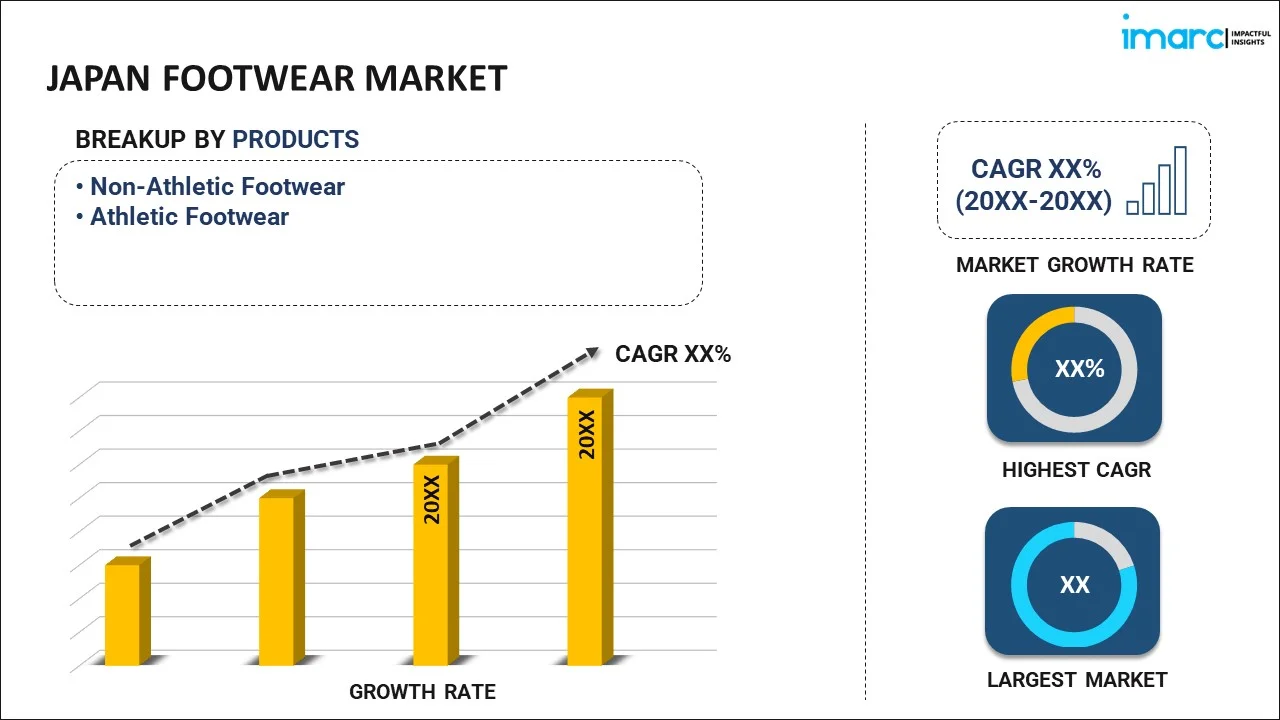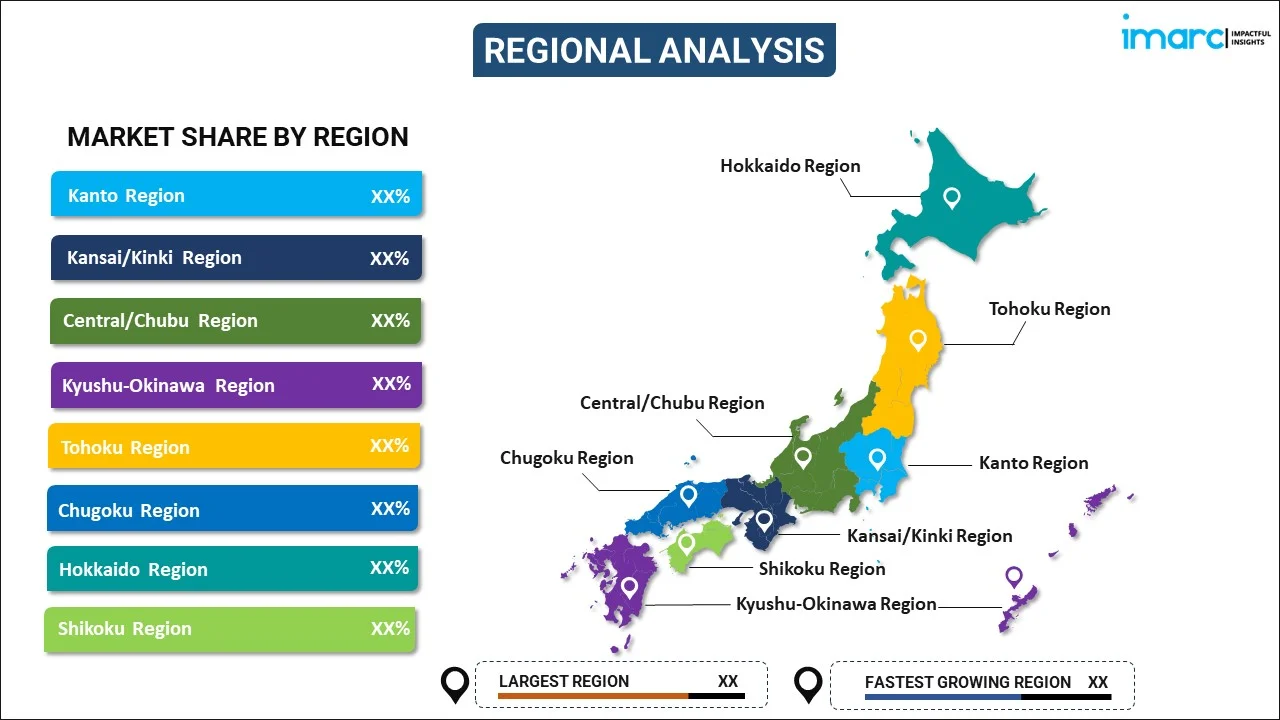
Japan Footwear Market Report by Product (Non-Athletic Footwear, Athletic Footwear), Material (Rubber, Leather, Plastic, Fabric, and Others), Distribution Channel (Footwear Specialists, Supermarkets and Hypermarkets, Departmental Stores, Clothing Stores, Online Sales, and Others), Pricing (Premium, Mass), End User (Men, Women, Kids), and Region 2025-2033
Market Overview:
The Japan footwear market size reached USD 12.4 Billion in 2024. Looking forward, IMARC Group expects the market to reach USD 16.0 Billion by 2033, exhibiting a growth rate (CAGR) of 2.66% during 2025-2033. The changing consumer preferences, improving economic factors, changing fashion trends, emerging e-commerce industry, increasing popularity of athletic and sports footwear, and rising concerns about environment sustainability represent some of the key factors driving the market.
|
Report Attribute
|
Key Statistics
|
|---|---|
|
Base Year
|
2024 |
|
Forecast Years
|
2025-2033 |
|
Historical Years
|
2019-2024
|
| Market Size in 2024 | USD 12.4 Billion |
| Market Forecast in 2033 | USD 16.0 Billion |
| Market Growth Rate (2025-2033) | 2.66% |
Footwear refers to any covering or accessory designed to be worn on the feet for protection, comfort, or style. This broad category encompasses a wide range of items, including shoes, sandals, boots, slippers, and more. Footwear serves a crucial dual purpose as it safeguards feet from environmental hazards like rough terrain, extreme temperatures, and sharp objects, while also contributing to the overall comfort and well-being. In contemporary society, footwear plays a multifaceted role, such as it serves functional purposes by offering support and protection, and it also makes a significant fashion statement. Footwear choices convey individual style, social status, and personal identity. Moreover, the right pair of footwear is essential for both comfort and style for a casual stroll, a formal event, or athletic pursuits.
Japan Footwear Market Trends:
Japanese consumers have become increasingly fashion-conscious and health-conscious, due to which they seek both style and comfort in their footwear choices. This shift in preferences has led to a surge in the demand for innovative and comfortable footwear options. Additionally, as individuals age, there is a greater need for specialized footwear that caters to comfort and orthopedic concerns. This demographic trend has accelerated the sales of supportive and ergonomic footwear solutions. Other than this, the overall economic stability in Japan plays a pivotal role. As the economy grows, consumers are more willing to invest in higher-quality, branded footwear. Conversely, economic downturns can affect consumer spending on non-essential items, impacting the footwear market. Besides this, Japan is known for its fashion-forward culture. The country sets trends in various industries, including footwear. Collaborations with international brands, celebrity endorsements, and unique designs influence the purchasing decisions of fashion-savvy consumers. In line with this, the rise of e-commerce platforms has transformed the retail landscape. Online shopping offers convenience and a wide range of choices. The footwear market benefits from this trend as consumers increasingly explores online options. Furthermore, sports and fitness have gained popularity in Japan. The demand for athletic and sports footwear has surged as more individuals engage in physical activities. Innovative technologies in sports footwear attract consumers seeking performance-enhancing features. Apart from these factors, the rising concerns about the environment have led to a growing interest in eco-friendly and sustainable footwear. As a result, companies that prioritize sustainability and use recycled materials have gained a competitive edge in the Japanese market. Moreover, government regulations and standards for footwear quality and safety impact the market. Compliance with these regulations is essential for manufacturers and importers.
Japan Footwear Market Segmentation:
IMARC Group provides an analysis of the key trends in each segment of the market, along with forecasts at the country level for 2025-2033. Our report has categorized the market based on product, material, distribution channel, pricing, and end user.
Product Insights:

- Non-Athletic Footwear
- Athletic Footwear
The report has provided a detailed breakup and analysis of the market based on the product. This includes non-athletic footwear and athletic footwear.
Material Insights:
- Rubber
- Leather
- Plastic
- Fabric
- Others
A detailed breakup and analysis of the market based on the material have also been provided in the report. This includes rubber, leather, plastic, fabric, and others.
Distribution Channel Insights:
- Footwear Specialists
- Supermarkets and Hypermarkets
- Departmental Stores
- Clothing Stores
- Online Sales
- Others
The report has provided a detailed breakup and analysis of the market based on the distribution channel. This includes footwear specialists, supermarkets and hypermarkets, departmental stores, clothing stores, online sales, and others.
Pricing Insights:
- Premium
- Mass
A detailed breakup and analysis of the market based on the pricing have also been provided in the report. This includes premium and mass.
End User Insights:
- Men
- Women
- Kids
The report has provided a detailed breakup and analysis of the market based on the end user. This includes men, women, and kids.
Regional Insights:

- Kanto Region
- Kansai/Kinki Region
- Central/ Chubu Region
- Kyushu-Okinawa Region
- Tohoku Region
- Chugoku Region
- Hokkaido Region
- Shikoku Region
The report has also provided a comprehensive analysis of all the major regional markets, which include Kanto Region, Kansai/Kinki Region, Central/ Chubu Region, Kyushu-Okinawa Region, Tohoku Region, Chugoku Region, Hokkaido Region, and Shikoku Region.
Competitive Landscape:
The market research report has also provided a comprehensive analysis of the competitive landscape. Competitive analysis such as market structure, key player positioning, top winning strategies, competitive dashboard, and company evaluation quadrant has been covered in the report. Also, detailed profiles of all major companies have been provided.
Japan Footwear Market Report Coverage:
| Report Features | Details |
|---|---|
| Base Year of the Analysis | 2024 |
| Historical Period | 2019-2024 |
| Forecast Period | 2025-2033 |
| Units | Billion USD |
| Scope of the Report | Exploration of Historical and Forecast Trends, Industry Catalysts and Challenges, Segment-Wise Historical and Predictive Market Assessment:
|
| Products Covered | Non-Athletic Footwear, Athletic Footwear |
| Materials Covered | Rubber, Leather, Plastic, Fabric, Others |
| Distribution Channels Covered | Footwear Specialists, Supermarkets and Hypermarkets, Departmental Stores, Clothing Stores, Online Sales, Others |
| Pricings Covered | Premium, Mass |
| End Users Covered | Men, Women, Kids |
| Regions Covered | Kanto Region, Kansai/Kinki Region, Central/ Chubu Region, Kyushu-Okinawa Region, Tohoku Region, Chugoku Region, Hokkaido Region, Shikoku Region |
| Customization Scope | 10% Free Customization |
| Post-Sale Analyst Support | 10-12 Weeks |
| Delivery Format | PDF and Excel through Email (We can also provide the editable version of the report in PPT/Word format on special request) |
Key Questions Answered in This Report:
- How has the Japan footwear market performed so far and how will it perform in the coming years?
- What has been the impact of COVID-19 on the Japan footwear market?
- What is the breakup of the Japan footwear market on the basis of product?
- What is the breakup of the Japan footwear market on the basis of material?
- What is the breakup of the Japan footwear market on the basis of distribution channel?
- What is the breakup of the Japan footwear market on the basis of pricing?
- What is the breakup of the Japan footwear market on the basis of end user?
- What are the various stages in the value chain of the Japan footwear market?
- What are the key driving factors and challenges in the Japan footwear?
- What is the structure of the Japan footwear market and who are the key players?
- What is the degree of competition in the Japan footwear market?
Key Benefits for Stakeholders:
- IMARC’s industry report offers a comprehensive quantitative analysis of various market segments, historical and current market trends, market forecasts, and dynamics of the Japan footwear market from 2019-2033.
- The research report provides the latest information on the market drivers, challenges, and opportunities in the Japan footwear market.
- Porter's five forces analysis assist stakeholders in assessing the impact of new entrants, competitive rivalry, supplier power, buyer power, and the threat of substitution. It helps stakeholders to analyze the level of competition within the Japan footwear industry and its attractiveness.
- Competitive landscape allows stakeholders to understand their competitive environment and provides an insight into the current positions of key players in the market.
Need more help?
- Speak to our experienced analysts for insights on the current market scenarios.
- Include additional segments and countries to customize the report as per your requirement.
- Gain an unparalleled competitive advantage in your domain by understanding how to utilize the report and positively impacting your operations and revenue.
- For further assistance, please connect with our analysts.
 Inquire Before Buying
Inquire Before Buying
 Speak to an Analyst
Speak to an Analyst
 Request Brochure
Request Brochure
 Request Customization
Request Customization




.webp)




.webp)












